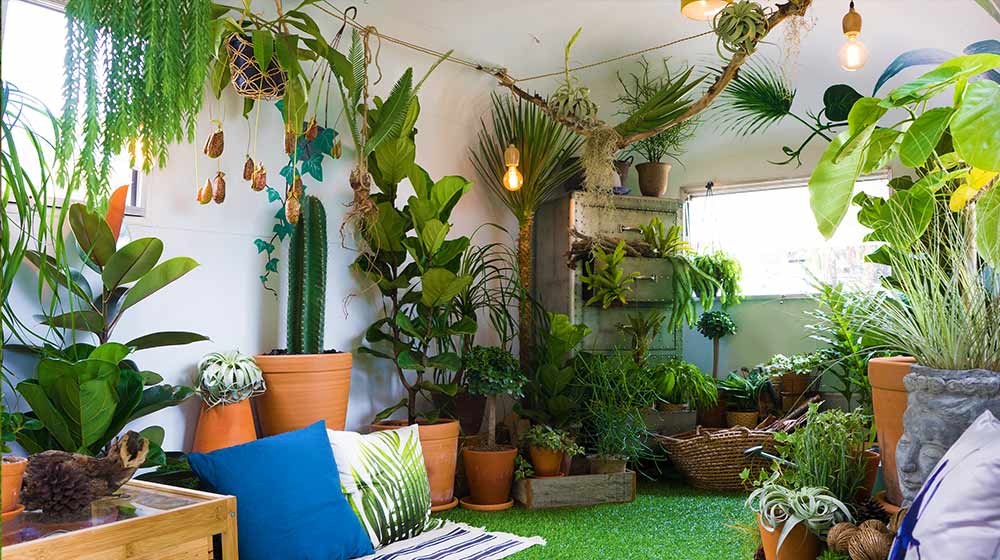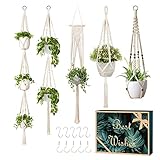The basics on apartment gardening are must-know for budding urban gardeners. The process is a realization that you can do so much with the little space you have in your apartment.
I'll be outlining some expert tips to help you start apartment gardening.
RELATED: Small Garden Ideas And Tips | How To Design Gardens In Limited Spaces
Apartment Gardening Guide for Modern Urban Gardeners
Step 1. Choose Your First Plants
[instagram url=https://www.instagram.com/p/CBPe19egJL2/ hidecaption=true width=800]
Technically, you can grow any plant in a container, but with limitations. Fruit trees, for instance, have dwarf varieties you can grow in small spaces. Your choice of plants will largely depend on your dedication and available resources, most especially your time.
1. Succulents
[instagram url=https://www.instagram.com/p/CAf-dbkg8zl/ hidecaption=true width=800]
For many neophyte plant lovers, starting small is the easiest way to start with apartment gardening. If you're taking this path and you're a bit unsure of the time you can devout to gardening, you can start with succulents. They're easy to take care of and would require very little of your time.
There are a lot of varieties you can choose from. You can try the all-time favorite jade plant, or the trailing Burro's Tail succulent, and the String of Pearls for hanging baskets. Aloe vera varieties will be a good start as well.
2. House Plants and Flowers
@_thevibespaceFeeling extra grateful on this Friday morning. ##urbanjungle ##blessed ##plants ##fyp ##foryoupage ##houseplants♬ ily (i love you baby) – Surf Mesa
Most first-time urban gardeners opt for house plants since they're easier to manage and are engineered as indoor plants. Starting with flowering or nonflowering houseplants is a good choice because they help filter the air in your room and provide a relaxing atmosphere to help you live a balanced lifestyle.
You can commence your apartment gardening with health-boosting plants such as snake plant, dracaena, spider plant, and bird's nest fern.
For those who adore flowers, go for annuals like African violets, begonias, geraniums, lilies, pansies, and petunias. They're easy-care flowers that offer vibrant and colorful blooms.
3. Indoor Herb Garden
[instagram url=https://www.instagram.com/p/BipDAOzAyWc/ hidecaption=true width=800]
If you love flavors in your kitchen, some homegrown herbs and spices will be perfect. Lucky for us, herbs do well in containers and tight spaces.
Your kitchen window will be a good spot for growing basil, chives, lavender, parsley, rosemary, and thyme. Throw in some chili pepper plants to add some spice to your indoor herb gardening.
4. Edible Garden
[instagram url=https://www.instagram.com/p/CA-vWPzHN2s/ hidecaption=true width=800]
Now, if you're really into growing your own food supply, there are vegetables and fruits that are suited for indoor gardens. To start, a salad garden will work just fine inside your apartment. Most of these greens are shallow-rooted, so containers are enough. Just make sure you give them plenty of water to thrive.
For some refreshing fruits to grow, dwarf citrus plants like Meyer lemons are on top of the list. It's also possible to grow some strawberries in your window space.
RELATED: How To Care For Indoor Plants | Garden Season Tips
Step 2. Prepare Your Indoor Planting Sites
@theplantbitchmy love 😍😍😍 ##plants ##plantsoftiktok ##indoorplants ##houseplants ##plantparent ##plantmom♬ Midnight City – M83
After you've decided what plants to grow in your mini garden, you now can revisit your apartment's layout. In evaluating available space, here are some key things to consider:
Humidity
@mykielikesitStimulating rain. ##rain ##water ##plants ##indoorplants ##garden ##spraybottle ##hairychest ##daddy ##gay ##fyp ##happy ##gnome ##loft ##urbanjungle ##lgbtq♬ Singing In The Rain – Gene Kelly
Depending on the plant you're growing, humidity is often an important factor in indoor planting. An average apartment usually has a humidity of below 30% while most plants thrive in a 40-60% humidity. Rooms like the kitchen and the laundry areas are generally more humid.
If your home lacks the humidity plants (and people) require, you can try to do the following:
- Misting. This is a temporary solution to raise humidity around your plants. Spray your plants with distilled or filtered water at least twice a day.
- Humidifier. Especially during the cold and dry season, a humidifier is your plants' ally. Some people express concern that humidifiers lead to mold in the house. And this is valid. What I do is I put the humidifier on an elevated platform and away from the floor and walls.
- Plant Huddle. This is a method of placing several plants close to each other to create a microclimate to maintain ideal humidity level. You can put a dish with water in the middle to hasten increasing humidity.
- Pebble Trays. It is an easy DIY solution for increasing humidity around the plant. Place some clean pebbles on a tray and pour some water. Put plants on top of the tray. The slow evaporation process will increase humidity as well.
Sunlight
[instagram url=https://www.instagram.com/p/CBQiIdDA2WI/ hidecaption=true width=800]
You should know your plants' requirement for sunlight. Some will need full and direct sun exposure while some can survive on minimal lighting conditions.
You can maximize open areas like patios to convert to your apartment garden. Windows and windowsills are also a good area to develop for your indoor garden.
Available Resources
[instagram url=https://www.instagram.com/p/CBQnhArhsAq/ hidecaption=true width=800]
Make most out of open spaces by doing DIY trays and plant holders without sacrificing your and your family's comfort. For homes with high ceilings, you can consider hanging planters as well. Some expert gardeners employ a mobile garden tray to allow their plants to follow the sunlight.
Step 3. Select Your Planters and Pots
[instagram url=https://www.instagram.com/p/CBGs9Kyp49-/ hidecaption=true width=800]
With efficiency in mind, choose planters that amplify your apartment's space. Window ledges are a good place to put a long planter that would carry several sun-loving plants. Don't forget to turn these planters around once in a while to get them growing upright.
Vertical gardening is another option. Some green thumbs with tight spaces often create their garden against a wall. This saves so much space since plants occupy the same spot.
Hanging planters are gardening staples in a studio or small space apartment as well. Vining plants hanging from these planters are sights to behold.
Lastly, make sure your plants and pots maintain the overall theme and design of your apartment. Play with colors, shapes, and textures to achieve your desired aesthetics.
Bonus Tip: Invest in Garden Technologies
[instagram url=https://www.instagram.com/p/CBC0drLgqRA/ hidecaption=true width=800]
New techs and applications available in the market can make your urban gardening better and easier. There are gadgets and devices you can use to track your plant's growth and requirements. Grow light can compensate for rooms with little lighting.
You can also explore smart indoor garden sets that automate all tasks related to apartment gardening.
Watch this video from Truly on how a New York fashion model turns her apartment into an urban jungle:
We all start somewhere. One plant today can lead to a multitude of varieties in your indoor garden. Now that you've acquired you the basic knowledge of apartment gardening, it's time to pay a garden store a visit and start filling your room with plants!
To synthesize, everyone can be a gardener. Every space, no matter how small, can be a haven for our green friends.
What plants will you grow in your apartment garden? Let us know in the comments section below.
Up Next:
- Foolproof Indoor Gardening With 19 Of The Top Indoor Crops
- 3 Smart Small Space Gardening Ideas And Tips For The City Dwellers
- Everything You Need To Know About Bokashi Composting
Calling all green thumbs, Garden Season needs YOU! Click here if you want to contribute for us!
Want to stay up to date? Follow Garden Season on Facebook, Twitter, Instagram, and Pinterest.








